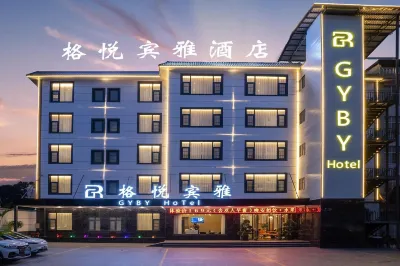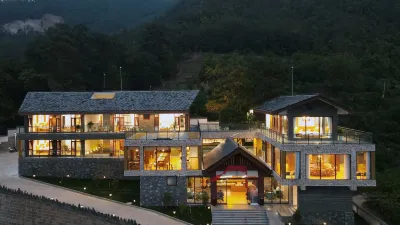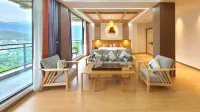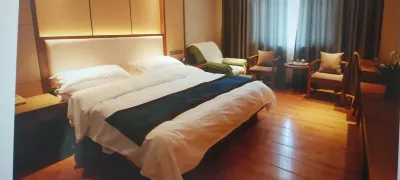
Search Best Hotels in Jingdong
Enter your dates for the latest hotel rates and availability.
Hot travel dates
Today
Tomorrow
Next Weekend
March 2025
- Mon
- Tue
- Wed
- Thu
- Fri
- Sat
- Sun
- 1
- 2
- 3
- 4
- 5
- 6
- 7
- 8
- 9
- 10
- 11
- 12
- 13
- 14
- 15
- 16
- 17
- 18
- 19
- 20
- 21
- 22
- 23
- 24
- 25
- 26
- 27
- 28
- 29
- 30
- 31
April 2025
- Mon
- Tue
- Wed
- Thu
- Fri
- Sat
- Sun
- 1
- 2
- 3
- 4
- 5
- 6
- 7
- 8
- 9
- 10
- 11
- 12
- 13
- 14
- 15
- 16
- 17
- 18
- 19
- 20
- 21
- 22
- 23
- 24
- 25
- 26
- 27
- 28
- 29
- 30
Swipe up to view more
Filter by:
Hotel Star Rating
≤2345
Popular Filters
Amazing 4.5+Great 4.0+Good 3.5+Pleasant 3.0+15 hotels in Jingdong for your stay
Choose your travel dates to see the latest prices and deals.
Most Booked
Lowest Price
Closest to Downtown
Highest Rated



Hotel near Jingdong
GGuest User 2024.09.08
This hotel is simply a treasure. In a botanical garden, children increase their knowledge, and professional plant teachers lead the team. The hotel has a beautiful environment, Ailao Mountain, and Wuliang Mountain at the junction of the two mountains. There is a river in the middle, it seems to be called the Sichuan River, and there is a beach camp by the river. It is not too cool to barbecue here at night;
Outstanding
66 reviews
4.6/5
Price from
₹ 10,448
per night



Hotel near Jingdong
GGuest User 2023.01.14
Just opened. Just a few days. The room was very clean and tidy. The staff is also very polite.
Passing by this small county on the way from Xishuangbanna to Dali, I randomly chose Vienna. The stay experience is good.
The room just finished the decoration and it smelled a little bit, not noisy.
If you have environmental requirements for accommodation, you can consider this one. Others are private hotels of the kind.
Outstanding
157 reviews
4.8/5
Price from
₹ 2,465
per night



Hotel near Jingdong
GGuest User 2024.11.25
The hotel is newly repaired, the location is easy to find, there is a parking lot, I came to the business trip to screen and stayed for two nights. The room layout is very comfortable. Sleeping at night is very quiet, shopping and supper are around, bathing hot water is fast, and free laundry service is provided. Linjiang can see the mountains. The experience is full.
The boss and staff are very enthusiastic, and two problems were found when they lived:
1. I checked in around 3:30 in the afternoon, but there are water stains on the toilet seat and inner cover after cleaning. It should be cleaned and not paid attention to.
2. The boss should not pay attention to the selection of the bath handle. The place where the hanging is a bit sharp, the bath interface department has scratched the paint.
Overall does not affect the stay experience, recommended stay
Outstanding
203 reviews
4.7/5
Price from
₹ 1,755
per night

You Might Like
Hotels With BreakfastHotels With Twin RoomHotels With 1 Double BedHotels With Swimming PoolHotels With Free Cancellation



Hotel near Jingdong
GGuest User 2024.04.26
Located in the deep mountains of Huangcaoling, the superb Mid-Levels Hotel, staying for two nights is still not enough. Each room has a nice name, especially recommended to listen to the ape-2. Super large room, super large terrace, excellent privacy, great value for money. You can sit quietly for a whole day, face the mountains stacked like ink paintings, the virgin forest vegetation is lush, listen to the wind, listen to the birds and listen to the apes. The younger brother and sister at the front desk are all local youths, simple, warm and talkative and professional, more humane than star hotels. Now it is the cherry harvest season, sweet and juicy cherries with the black bone chickens of the nearby farmhouse, the first choice for vacation and leisure.
Outstanding
69 reviews
4.7/5
Price from
₹ 2,597
per night



Hotel near Jingdong
AAnonymous User 2024.03.09
The room is clean and tidy, the hotel has its own independent parking lot, convenient self-driving parking, very close to the passenger station, the door is the main road of the city, it is convenient to go out and take a taxi.
Outstanding
113 reviews
4.8/5
Price from
₹ 1,635
per night



Hotel near Jingdong
KKakarote 2024.08.25
The service attitude is very good, and the room has been upgraded. It is very convenient to eat and play in the city. The total amount is very good 👍🏻 recommended! ! ! !
Outstanding
135 reviews
4.8/5
Price from
₹ 1,407
per night



Hotel near Jingdong
GGuest User 2024.09.04
Every time I go back to Jingdong, I must stay at a hotel. It is very delicious early. It is also very convenient to travel. The sanitation is also very clean. Parking and the surrounding environment are also very good. It is also very convenient to go out for a late night.
Excellent
103 reviews
4.4/5
Price from
₹ 1,443
per night



Outstanding
11 reviews
4.6/5
Price from
₹ 553
per night



Hotel near Jingdong
GGuest User 2024.12.13
You can park, there are many parking spaces, very nice
39 reviews
3.9/5
Price from
₹ 1,046
per night



3 reviews
3.3/5
Price from
₹ 517
per night
Latest Reviews for Jingdong hotels
See all
Explore honest ratings and real traveler reviews to help you find the perfect stay.
4.9/5
Perfect
GGuest UserThe room facilities are fully equipped, a few meters away is the park. Very good.
4.8/5
Outstanding
GGanbangpaxibadakeshiqueThis is the most cost-effective hotel I have ever stayed in. The landlady is very nice and she even provided me with washing powder. The interior environment is comparable to hotels costing more than 100 yuan.
4.8/5
Outstanding
KKakaroteThe service attitude is very good, and the room has been upgraded. It is very convenient to eat and play in the city. The total amount is very good 👍🏻 recommended! ! ! !
4.8/5
Outstanding
HHongzao6688Good, clean and hygienic
4.8/5
Outstanding
GGuest UserThe homestay is close to the highway, it is very convenient to go back and forth, the boss is very enthusiastic, invited us to make tea, go to the garden to pick oranges and oranges, we originally planned to stay for one night, but we were attracted by the beauty of the homestay, and we took pictures again. We went to the field next to it. Walking, playing for a long time, We just finished walking for two days, the clothes on our bodies were dirty, the boss found a place for us to wash the clothes, when we left, the boss bought bananas, and stuffed a few in our pockets without saying anything, for the children to eat, was pleasantly surprised by an experience, like it here
4.7/5
Outstanding
GGuest UserVery good hotel, I originally booked a standard bed room, because the room was fully booked, the front desk little beauty gave me a free upgrade to the comfortable bed room, unlike some hotels to ask you to add money. The room and bathroom are large, the room is fully equipped, clean and tidy. And some parts of the hotel are meticulous and feel very warm. These are not available in other hotels: 1. As soon as I got out of the elevator, I saw the message wall, which was covered with a variety of messages. There were various materials and pens next to it for message use. 2. There is also a message book in the room, and it is very interesting to read it all. 3. The room has a free data cable to charge, and there is a private mirror next to the data cable to get you up and use it. 4. So many hotels I have stayed in are the only ones with brushes and soap in the bathroom. 5. There is a water dispenser in the room to boil water and make tea, which gives people a very clean and hygienic feeling.
4.4/5
Excellent
GGuest UserEvery time I go back to Jingdong, I must stay at a hotel. It is very delicious early. It is also very convenient to travel. The sanitation is also very clean. Parking and the surrounding environment are also very good. It is also very convenient to go out for a late night.
3.9/5
GGuest UserYou can park, there are many parking spaces, very nice
3.8/5
GGuest UserThe hotel is very good, all aspects of service are meticulous and thoughtful, suitable for staying
FAQs About Hotels in Jingdong
Which hotels in Jingdong offer airport shuttle service?
Not familiar with Jingdong? Jingdong Xianglong Hotel, Huangcaoling Wuliang Secret Hotel and Huangma Hotel provide airport transfer services.
What hotel deals are available in Jingdong?
Trip.com offers various events and deals to its users all year round. You can check the deals page to view Trip.com deals.
What are the best hotels with a spa in Jingdong?
Planning a trip? A spa visit can be a wonderful part of your travel experience. Jingdong Xianglong Hotel, Huangcaoling Wuliang Secret Hotel and Jingdong Kerry Hotel provide highly rated spa services.
Which hotels in Jingdong have swimming pools?
Huangcaoling Wuliang Secret Hotel is a hotel with swimming pools. Stay at any of these hotels to enjoy a swimming pool!
Which hotels in Jingdong offer free WiFi?
Whether you are travelling for business or vacation, an internet connection is a must for your trip. Jingdong Xianglong Hotel, Huangma Hotel and Huangcaoling Wuliang Secret Hotel are popular hotels with free Wi-Fi.
Is Jingdong pet-friendly?
Huangcaoling Wuliang Secret Hotel allows pets. Take your pets with you during your stay!
What are some recommended family-friendly hotels in Jingdong?
Jinlian Mountain Rooms and Bingyingge are very suitable for family travel. Enjoy your trip with all the family!
Which hotels in Jingdong have fitness facilities?
Jingdong Xianglong Hotel, Huangcaoling Wuliang Secret Hotel and Huangma Hotel provide fitness facilities. Satisfy your fitness needs even while traveling!
Which hotels in Jingdong provide high-quality breakfasts?
Huangcaoling Wuliang Secret Hotel,Huangma Hotel and Jingdong Geyue Binya Hotel provide high-quality breakfast. Start your day with delicious breakfast!
What is the average hotel price in Jingdong?
For hotels in Jingdong, the average price on weekdays is ₹ 1,725, the average price on weekends (Friday–Saturday) is ₹ 1,729.
What are the most popular hotels in Jingdong?
Jingdong has many popular hotels. Whether you're traveling for business or going on a vacation, Jingdong Xianglong Hotel, Huangcaoling Wuliang Secret Hotel and Jingdong Kerry Hotel are preferred hotels.
Hotel Information for Tourists
| Highest Price | ₹ 6,613 |
|---|---|
| Lowest Price | ₹ 457 |
| Number of Reviews | 2,997 |
| Total Properties | 124 |
| Average Price (Weekdays) | ₹ 1,725 |
| Average Price (Weekends) | ₹ 1,729 |